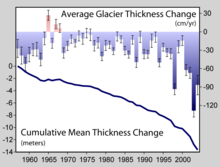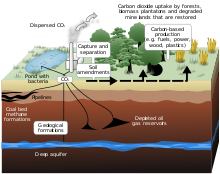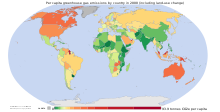The main tools for projecting future climate changes are mathematical models based on physical principles including fluid dynamics, thermodynamics and radiative transfer. Although they attempt to include as many processes as possible, simplifications of the actual climate system are inevitable because of the constraints of available computer power and limitations in knowledge of the climate system. All modern climate models are in fact combinations of models for different parts of the Earth. These include an atmospheric model for air movement, temperature, clouds, and other atmospheric properties; an ocean model that predicts temperature, salt content, and circulation of ocean waters; models for ice cover on land and sea; and a model of heat and moisture transfer from soil and vegetation to the atmosphere. Some models also include treatments of chemical and biological processes.[73] Warming due to increasing levels of greenhouse gases is not an assumption of the models; rather, it is an end result from the interaction of greenhouse gases with radiative transfer and other physical processes.[74] Although much of the variation in model outcomes depends on the greenhouse gas emissions used as inputs, the temperature effect of a specific greenhouse gas concentration (climate sensitivity) varies depending on the model used. The representation of clouds is one of the main sources of uncertainty in present-generation models.[75]
Global climate model projections of future climate most often have used estimates of greenhouse gas emissions from the IPCC Special Report on Emissions Scenarios (SRES). In addition to human-caused emissions, some models also include a simulation of the carbon cycle; this generally shows a positive feedback, though this response is uncertain. Some observational studies also show a positive feedback.[76][77][78] Including uncertainties in future greenhouse gas concentrations and climate sensitivity, the IPCC anticipates a warming of1.1 °C to 6.4 °C (2.0 °F to 11.5 °F) by the end of the 21st century, relative to 1980–1999.[2]
Models are also used to help investigate the causes of recent climate change by comparing the observed changes to those that the models project from various natural and human-derived causes. Although these models do not unambiguously attribute the warming that occurred from approximately 1910 to 1945 to either natural variation or human effects, they do indicate that the warming since 1970 is dominated by man-made greenhouse gas emissions.[31]
The physical realism of models is tested by examining their ability to simulate current or past climates.[79] Current climate models produce a good match to observations of global temperature changes over the last century, but do not simulate all aspects of climate.[42] Not all effects of global warming are accurately predicted by the climate models used by the IPCC. For example, observed Arctic shrinkage has been faster than that predicted.[80]
Attributed and expected effects
Global warming may be detected in natural, ecological or social systems as a change having statistical significance.[81] Attribution of these changes e.g., to natural or human activities, is the next step following detection.[82]
Natural systems
Global warming has been detected in a number of systems. Some of these changes, e.g., based on the instrumental temperature record, have been described in the section on temperature changes. Rising sea levels and observed decreases in snow and ice extent are consistent with warming.[17] Most of the increase in global average temperature since the mid-20th century is, with high probability,[D] atttributable to human-induced changes in greenhouse gas concentrations.[83]
Even with current policies to reduce emissions, global emissions are still expected to continue to grow over the coming decades.[84] Over the course of the 21st century, increases in emissions at or above their current rate would very likely induce changes in the climate system larger than those observed in the 20th century.
In the IPCC Fourth Assessment Report, across a range of future emission scenarios, model-based estimates of sea level rise for the end of the 21st century (the year 2090-2099, relative to 1980-1999) range from 0.18 to 0.59 m. These estimates, however, were not given a likelihood due to a lack of scientific understanding, nor was an upper bound given for sea level rise. Over the course of centuries to millennia, the melting of ice sheets could result in sea level rise of 4–6 m or more.[85]
Changes in regional climate are expected to include greater warming over land, with most warming at high northern latitudes, and least warming over the Southern Ocean and parts of the North Atlantic Ocean.[84] Snow cover area and sea ice extent are expected to decrease. The frequency of hot extremes, heat waves, and heavy precipitation will very likely increase.
Ecological systems
In terrestrial ecosystems, the earlier timing of spring events, and poleward and upward shifts in plant and animal ranges, have been linked with high confidence to recent warming.[17] Future climate change is expected to particularly affect certain ecosystems, including tundra,mangroves, and coral reefs.[84] It is expected that most ecosystems will be affected by higher atmospheric CO2 levels, combined with higher global temperatures.[86] Overall, it is expected that climate change will result in the extinction of many species and reduced diversity of ecosystems.[87]
Social systems
There is some evidence of regional climate change affecting systems related to human activities, including agricultural and forestrymanagement activities at higher latitudes in the Northern Hemisphere.[17] Future climate change is expected to particularly affect some sectors and systems related to human activities.[84] Water resources may be stressed in some dry regions at mid-latitudes, the dry tropics, and areas that depend on snow and ice melt. Reduced water availability may affect agriculture in low latitudes. Low-lying coastal systems are vulnerable to sea level rise and storm surge. Human health in populations with limited capacity to adapt to climate change. It is expected that some regions will be particularly affected by climate change, including the Arctic, Africa, small islands, and Asian and African megadeltas. Some people, such as the poor, young children, and the elderly, are particularly at risk, even in high-income areas.
Responses to global warming
Mitigation
Reducing the amount of future climate change is called mitigation of climate change. The IPCC defines mitigation as activities that reduce greenhouse gas (GHG) emissions, or enhance the capacity of carbon sinks to absorb GHGs from the atmosphere.[88] Many countries, bothdeveloping and developed, are aiming to use cleaner, less polluting, technologies.[45]:192 Use of these technologies aids mitigation and could result in substantial reductions in CO2 emissions. Policies include targets for emissions reductions, increased use of renewable energy, and increased energy efficiency. Studies indicate substantial potential for future reductions in emissions.[89] Since even in the most optimistic scenario, fossil fuels are going to be used for years to come, mitigation may also involve carbon capture and storage, a process that traps CO2produced by factories and gas or coal power stations and then stores it, usually underground.[90]
Adaptation
Other policy responses include adaptation to climate change. Adaptation to climate change may be planned, e.g., by local or national government, or spontaneous, i.e., done privately without government intervention.[91] The ability to adapt is closely linked to social andeconomic development.[89] Even societies with high capacities to adapt are still vulnerable to climate change. Planned adaptation is already occurring on a limited basis. The barriers, limits, and costs of future adaptation are not fully understood.
Another policy response is engineering of the climate (geoengineering). This policy response is sometimes grouped together with mitigation.[92] Geoengineering is largely unproven, and reliable cost estimates for it have not yet been published.[93]
UNFCCC
Most countries are Parties to the United Nations Framework Convention on Climate Change (UNFCCC).[94] The ultimate objective of the Convention is to prevent "dangerous" human interference of the climate system.[95] As is stated in the Convention, this requires that GHGs are stabilized in the atmosphere at a level where ecosystems can adapt naturally to climate change, food production is not threatened, and economic development can proceed in a sustainable fashion.
The UNFCCC recognizes differences among countries in their responsibility to act on climate change.[96] In the Kyoto Protocol to the UNFCCC, most developed countries (listed in Annex I of the treaty) took on legally binding commitments to reduce their emissions.[97] Policy measures taken in response to these commitments have reduced emissions.[98] For many developing (non-Annex I) countries, reducingpoverty is their overriding aim.[99]
At the 15th UNFCCC Conference of the Parties, held in 2009 at Copenhagen, several UNFCCC Parties produced the Copenhagen Accord.[100] Parties agreeing with the Accord aim to limit the future increase in global mean temperature to below 2 °C.[101]
Views on global warming
There are different views over what the appropriate policy response to climate change should be.[102][103] These competing views weigh the benefits of limiting emissions of greenhouse gases against the costs. In general, it seems likely that climate change will impose greater damages and risks in poorer regions.[104]
Politics
Developing and developed countries have made different arguments over who should bear the burden of costs for cutting emissions. Developing countries often concentrate on per capita emissions, that is, the total emissions of a country divided by its population.[105] Per capita emissions in the industrialized countries are typically as much as ten times the average in developing countries.[106] This is used to make the argument that the real problem of climate change is due to the profligate and unsustainable lifestyles of those living in rich countries.[105] On the other hand, commentators from developed countries more often point out that it is total emissions that matter.[105] In 2008, developing countries made up around half of the world's total emissions of CO2 from cement production and fossil fuel use.[107]
The Kyoto Protocol, which came into force in 2005, sets legally binding emission limitations for most developed countries.[97] Developing countries are not subject to limitations. This exemption led the U.S. and Australia to decide not to ratify the treaty.[108][109] At the time, almost all world leaders expressed their disappointment over President Bush's decision.[109] Australia has since ratified the Kyoto protocol.[110]
Public opinion
In 2007–2008 Gallup Polls surveyed 127 countries. Over a third of the world's population was unaware of global warming, with people in developing countries less aware than those in developed, and those in Africa the least aware. Of those aware, Latin America leads in belief that temperature changes are a result of human activities while Africa, parts of Asia and the Middle East, and a few countries from the Former Soviet Union lead in the opposite belief.[111] In the Western world, opinions over the concept and the appropriate responses are divided. Nick Pidgeon of Cardiff University finds that "results show the different stages of engagement[clarification needed] about global warming on each side of the Atlantic"; where Europe debates the appropriate responses while the United States debates whether climate change is happening.[






No comments:
Post a Comment